Hello fellow lovers of all things green. It’s the time of year to divide things which may seem to contradict the oneness we feel with nature and each other. We have enough division in our world. Don’t you agree? However, dividing perennials is about creating more of a beautiful thing and sharing that beauty with others, which brings me to a bit of family history.
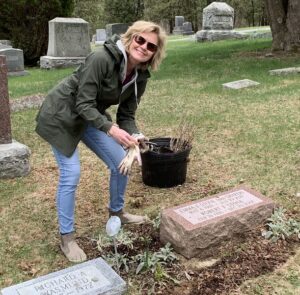
How perennial cuttings from my garden began
I traveled to Pine Bush, NY, to tend to my family’s plot, bringing a sack of garden tools, three of which I especially cherish, having been my dear old mom’s. The New Prospect Cemetery is modest, with headstones that dates back to the 1800s. Mom loved to tell the story of how her grandma, whom she called Baba, used to help herself to plant cuttings around the gravestones when they visited. And how her Aunt Bessie, who raised my mom, would scold Baba for taking plants.
“They would give them to me if they were here,” her comeback.
And as every generous gardener knows, Baba was right. It’s not stealing; It’s spreading joy and the gift of life, which inspired the idea to bring divides from my garden that first Spring after Mom passed away and plant them around the family’s headstone.
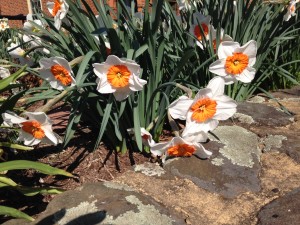
Daffodils Bring Happiness
The Lineup of Divided Perennials Shared
Before leaving, I considered digging up a clump of daffodils. But I thought I had brought some last spring. Plus, plants in full bloom are not the ideal time for them to make a move.
Daffys are blooming more bountifully than years past. I adore the garden of daffodils not far from here planted in the shape of a cross. Each year, they magically reach peak bloom on Easter Day, regardless of the weather. Hence, daffodils (Narcissus) are symbols of rebirth and new beginnings.
They say that yellow daffodils represent joy and positive energy. White represents purity and youth, while orange signifies hopefulness and camaraderie. They all say happiness.
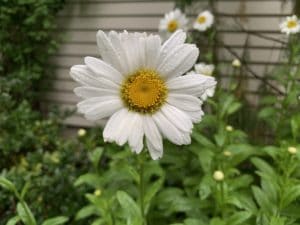
Leucanthemum × superbum ‘Becky’
The dried stems of the Shasta Daisies proved a bountiful source of summer blooms. And the Giant Lamb’s Ear (Stachys byzantina’ Helene von Stein,’ also called’ Big Ears’) was plentiful, taking over the Palace Purple Coral Bells.
I separated the Lamb’s Ear and planted them by the headstones of generations past, giving Coral Bells more room to flourish. There were indeed two sprigs of daffodil foliage to the left of the gravestone, but no promise of blooms this year. That’s okay; they’ll absorb enough nutrients to flower next Spring.
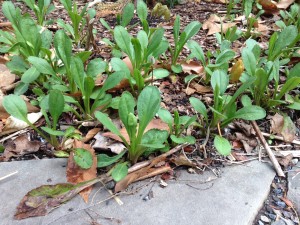
Ready to Divide Shasta Daisies
The Hosta divides were showing their little faces. I acquired them through the “Hosta Lady,” the mother-in-law of a dear friend who lived in Lancaster, PA. When she passed away, Paulette invited me to gather from her hundred varieties. Not knowing which ones I have, I call them all ‘Nancy,’ and I feel a connection, even though I never met her. There’s something about sharing roots.
The best time to divide perennials
Most say it’s best to divide Spring and Summer-blooming perennials in the Fall and Fall bloomers in the Spring. That way, all the plant’s energy can go to root and leaf development rather than flowering.
I say most perennials recover best if divided in early Spring, just as new growth emerges no matter when they bloom. The root systems are rich in stored energy and are less likely to suffer physical damage and leaf evaporation. Plus, the young foliage is easy to work around.
Making more of what you have without spending money is like finding a bargain. Sharing with others adds to the delight! And it rejuvenates the old and keeps ambitious, multiplying plants under control.
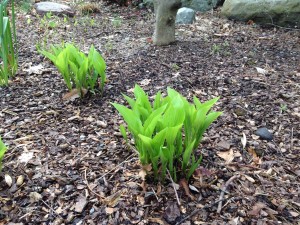
Ready to Divide Hosta
How to Divide Perennials
Before you dig up your plant, water it thoroughly and prepare the hole or pot. Choose a cloudy, chilly day—ideally when light rain is in the forecast—to keep the roots from drying out. There are two basic ways of dividing perennials.
Firm, dense roots, such as those of Hosta or ornamental grasses, need to be cut apart with a sharp knife or spade. It takes strength. You should see me jumping on the spade like a pogo stick to split the roots. Think of it as great exercise – and gardening is! Plus, it’s good for the soul.
Tangled and fibrous roots or clumps can be teased apart by hand or with two garden forks placed back-to-back and pulled gently apart.
So, make perennial divides and give them as gifts, making more plants for generations to come. Here’s to spreading joy.
Garden Dilemmas? AskMaryStone@gmail.com (and now on your favorite Podcast App.)
There’s more to the story in the Garden Dilemmas Podcast:

Can you plant daffodils in the Spring?
Jim of Washington, NJ, asked whether the daffodil bulbs he planted in March (having forgotten to plant them in the Fall) would bloom this year. Like most spring-blooming bulbs, most daffodils require a chilling period of below forty degrees for eight to twelve weeks to flourish. (Some more miniature daffodils don’t need the chill.) During the winter, bulbs are busy growing roots. Jim’s bulbs will push out only foliage this year. But next Spring, their sunny blooms will shine.
Links to Related Posts and Podcasts:
There are bulbs and corms you can plant now, as we discussed in Episode 197, “Favorite Spring-Planted Bulbs,” and Koleen’s Corncob Robber. I invite you to tune in.
Link to the Blog Post – Favorite Spring-Planted “Bulbs”
Episode 154 Root Pruning and the Journey of Growth
Root Pruning and Journey of Growth – Blog Post
A link to The American Daffodil Society


